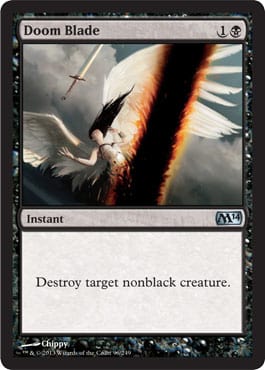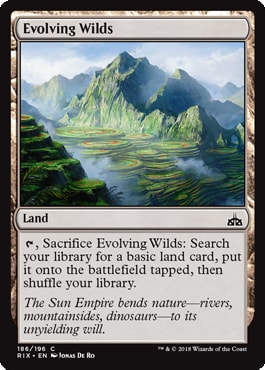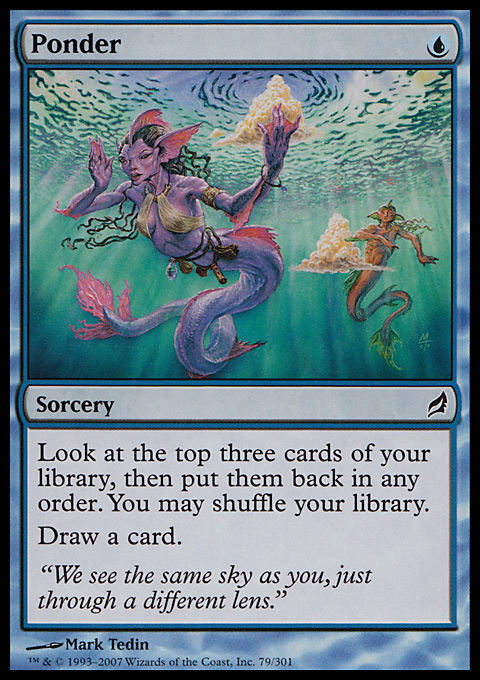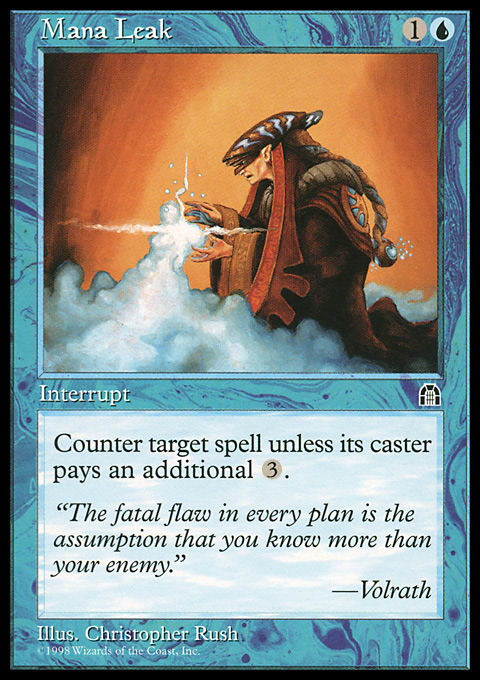Once again, for those of you who haven’t read the original Flores article, it’s here.
The article discusses a different way to think about deck strategy, and it’s one that I think is still slightly underused. People talk about card advantage all the time, but I actually think the core concepts brought to light by the concept of velocity are just as important, if not more important. Even so, Flores doesn’t go far enough. So today, I am going to talk about my expansion on this concept of velocity, and keeping with the physics theme, I’m going to call it momentum.
But first, let’s revisit the concept of velocity.
What is Velocity?
Velocity is the tendency of plays to build on one another. In essence, velocity deals with the fact that a play made slightly earlier can make the play you are making right now stronger. Let’s take a look at an example. Consider the following two creatures:
Watchwolf is a great example of a low-velocity play. Your second Watchwolf is just as good as your first, and your third is just as good as your second. However, Muscle Slivers improve the more that you have. In other words, your second Muscle Sliver builds on your first, and your third Muscle Sliver builds on the first two. This is how velocity operates. The idea that your cards gain increasing value as you draw them together is what the core concept is.
Slivers serve as the most obvious example of this. The tribe allows the group to gain abilities and bonuses as the number of Slivers on the board increases. In essence, each Sliver is better than all the Slivers played before it because it gains all the benefits from those Slivers.
Storm combo is another basic example of how velocity works. The strength of cards such as Past in Flames and Yawgmoth's Will are directly proportional to the cards played before them. Thus, the more cards you dump into the graveyard, the stronger these cards will be. The storm mechanic contributes to this as well—storm becomes successively stronger for each spell you’ve played that turn.
Velocity as a concept is related to positive-feedback loops. Essentially, these loops generate variable effectiveness. The individual strength of your card will vary on what else is being done and/or has been done. This is the key thing to remember about velocity: Cards help each other beyond the basic plan of, “I have two cards and can use them to do different things.” The more your deck is designed to take advantage of one or more of these positive-feedback loops, the more your deck will be able to generate velocity.
What’s the Problem with Velocity?
Velocity is divorced from many standard understandings of Magic. This isn’t to say it’s wrong or that it’s a bad idea, but it needs to be connected to what we know as a whole. The practical applications of the idea are, in general, fairly nebulous. Thus, the aim was to flesh out velocity as a concept.
When looking at concepts, it is frequently useful to examine their opposites, and this is true of velocity as well. In looking for a good way of dealing with velocity, I looked for its natural opposite. Velocity as a concept relates to how your cards interact with each other—specifically, that they build on each other in a profitable manner. Thus, each card relies not on its own individual merits, but on its merits as part of a greater whole. Essentially, velocity is based in synergy.
But we have an opposite to synergy: power. The other main way of taking advantage of cards relies on the individual cards to do a lot of work. In this method, the importance is placed not on how the cards interact with each other mechanically, but on their individual strengths. This is where cards such as Jace, the Mind Sculptor, Bloodbraid Elf, and Pernicious Deed shine. It is really just about playing the best cards to fulfill certain roles and coming out on top because your card quality is very high. This dichotomy led naturally into the use of momentum to unify existing concepts and velocity.
Defining Momentum
I know I wanted to correlate my unifying factor with one of two things: existing concepts or your ability to win the game. Thus, here is the definition of momentum:
Momentum is your ability to impact the game through your decisions this turn.
The key here is to look at the impact ability of all your decisions and not just any individual decision. Sure, each of your individual decisions might not be that impactful, but taken as a whole, frequently you can see that you do actually have a fair amount of momentum. Let’s take a look.
Your opponent’s plays over the first two turns are just two lands and an Avacyn's Pilgrim (which he pokes you with). You, playing Esper control, untap for turn three with Darkslick Shores, Seachrome Coast, and the following six-card hand:
 |
||
 |
Individually, the decision of whether to leave up Doom Blade and Mana Leak or play Ponder may not feel particularly powerful, but taken as a whole, this hand has a huge amount of momentum because of the number of options and collective impact this hand has. This is the key thing to look at.
The nice thing about looking at momentum this way is that it is directly correlated with your ability to win the game. If your decisions have overall higher levels of impact than your opponent’s, you are, in general, ahead, and you can leverage your decisions into a victory.
The good thing about momentum is that it also incorporates the value of open mana. This is because mana is almost always a prerequisite to having a decision available to you. By having mana available, your decisions become more powerful since you are allowed to make a greater variety of decisions.
This leads to one of the most important distinctions with momentum: There are two types. You can look at your momentum in the current, exact game state, or you can look at your expected momentum when you gain access to all of your resources again (your next turn). If you are tapped out, you have no responses, and effectively no momentum, at this very moment because you can’t make any decisions. However, that is often irrelevant—the expected momentum you possess at the start of your next turn will be very high.
There are two other nice things about momentum:
- Both players can generate momentum independently through their own play.
- When players collide (interact), momentum is largely preserved because any gain by one player is matched by a loss for the other player.
So, how does this relate to velocity? Well, physics tells us:
Thus, generating velocity allows us to generate momentum.
Looking at Inertia
Obviously, if momentum is going to be useful, there needs to be an analogy for mass. That is quite simple, though. Mass can be considered a quantification of the idea of inertia, and inertia proved to be the perfect concept to represent the idea of relying on card power. In essence, inertia proved to be the perfect counterpoint to velocity.
So, what is Inertia?
Much like in actual physics, inertia is the ability of your deck to resist attack from outside sources (forces). Inertia essentially is the resiliency of your deck and/or strategy. So, how do we accomplish or execute a high-inertia strategy? Why does this relate to the individual power level of your cards?
Well, consider the following two generic methodologies for attempting to accomplish a goal:
- Assemble a team and have its members work together on all aspects of the goal. Delegation occurs to some extent, but team members will help each other out as much as possible.
- Delegate each individual task to the person best suited to accomplish it and leave him or her alone.
If you are being results-oriented, both are effective means of accomplishing something and doing it well. They have their own risks, but as a whole, they work. Now, if you’ve been paying attention, you should begin to see the similarity of approach. The first one is like velocity, and the second is like inertia.
Why does the second approach create such resiliency—or inertia—in Magic?
The answer is that at its fundamental level, Magic is about interacting with your opponent’s cards in one form or another. Each card represents an effect, and the ability to interact with them is the basis of the game. In this methodology, your cards are like team members. If you are relying on them working together, cutting off one team member from another potentially results in nothing being accomplished. However, if you accept the basic premise that your team members are all operating independently, even if one becomes cut off, the others will still accomplish their tasks.
This latter approach is the card-power approach. By relying on individual cards to do individual jobs (or a variety of jobs), you are forced to select more efficient cards to fill those slots. Because you are not factoring in synergy, the prioritization is for efficient and powerful cards over synergistic ones. Sometimes, these are one and the same, but often, they are not.
Applying Inertia
Here are two examples of high-inertia strategies:
"Jund by Marijn Lybaert (Worlds 2009)"
- Creatures (16)
- 1 Borderland Ranger
- 3 Broodmate Dragon
- 4 Bloodbraid Elf
- 4 Putrid Leech
- 4 Sprouting Thrinax
- Planeswalkers (3)
- 3 Garruk Wildspeaker
- Spells (16)
- 2 Terminate
- 3 Bituminous Blast
- 4 Lightning Bolt
- 3 Maelstrom Pulse
- 4 Blightning
- Lands (40)
- 3 Forest
- 3 Mountain
- 4 Swamp
- 3 Dragonskull Summit
- 4 Rootbound Crag
- 4 Savage Lands
- 4 Verdant Catacombs
- 2 Caldera Hellion
- 3 Goblin Ruinblaster
- 3 Jund Charm
- 3 Mind Rot
- 2 Terminate
- 2 Thought Hemorrhage
"Caw Blade by Nick Spagnolo (SCG Open Dallas 2011)"
- Creatures (8)
- 4 Squadron Hawk
- 4 Stoneforge Mystic
- Planeswalkers (7)
- 3 Gideon Jura
- 4 Jace, the Mind Sculptor
- Spells (19)
- 1 Deprive
- 1 Stoic Rebuttal
- 3 Mana Leak
- 3 Spell Pierce
- 3 Day of Judgment
- 4 Preordain
- 1 Sword of Feast and Famine
- 1 Sylvok Lifestaff
- 2 Tumble Magnet
- Lands (26)
- 4 Plains
- 5 Island
- 1 Misty Rainforest
- 4 Celestial Colonnade
- 4 Glacial Fortress
- 4 Seachrome Coast
- 4 Tectonic Edge
Jund and Caw-Blade are two of the most recent in a long line of successful, high-inertia strategies. What makes them high-inertia is their inherent resistance to attack from various sources. Caw-Blade has a little bit of velocity associated with it as well, but really, the vast majority of the deck’s power level lies in its inertia.
The thing to note about these decks is that they have very little actual vulnerability. Jund and Caw-Blade could absorb punches that other decks would throw at them and just keep on trucking. To continue the physics analogy, other decks would attempt to interact with Jund and Caw-Blade (use force), but because of the inertia of these two decks, the end effect would be quite minimal. It would be as though you were trying to pick up a ten-ton rock with your bare hands. Sure, you can exert some force on the rock, but in the end, it’s certainly not enough to overcome the inertia of the rock. This was often the case with Caw-Blade and Jund: You could go ahead and do your thing, and Caw-Blade or Jund would just shrug it off.
If you are paying attention, there is something else you should note: Caw-Blade and Jund are both strategies centered very much on card advantage. This is not accidental. Card advantage and inertia are very much related. Frequently, high-card-advantage strategies rely on inertia to win because card advantage lends itself to these strategies.
Why is that?
Card advantage generates inertia because it increases the total resources you have access to. This lends itself to inertia-based strategies due to the selectivity you have from your increased resources. Because card advantage allows you to deploy your existing resources more effectively, deploying individually strong resources becomes a much better idea—you can put them in the best possible situation. In other words, drawing cards lets you choose when and where you play your individual cards more effectively. The stronger the individual cards you are playing, the more effective this type of strategy becomes.
But why doesn’t card advantage support velocity?
Card advantage doesn’t support velocity as well because the critical aspect of velocity is gaining critical mass. Velocity requires you to establish a certain mass of cards working together to overwhelm an opponent’s defenses. You can do this with card advantage (if you draw enough cards, you will eventually get there), but it is more effective to do this with speed. This is because your opponent’s interactions can raise your critical-mass requirement as the game goes along.
Vintage Storm is a great example of this. If you are on the play, all you have to beat is Force of Will. If your opponent has had a turn, you may have to worry about Flusterstorm, Spell Snare, Spell Pierce, Mana Drain, or all of the above. Each potential interaction your opponent has raises your effective critical mass because you have to win through the disruption. For this reason, many velocity decks use speed as a weapon because it’s easier to threaten low critical mass early than high critical mass late.
Relating Inertia, Velocity, and Momentum
The physics equation does a good job relating these three in a Magic sense as well. In physics, you can have similar momentum in two different objects by varying mass and velocity inversely. For any given momentum, a high mass will result in a low velocity, and a low mass will result in a high velocity.
This mirrors the Magic relationship well. Decks can have strong ability to interact and make relevant decisions in all stages of the game, but they can get there by relying on either velocity or inertia. There is a balance that can be achieved, and the pendulum can exist almost anywhere on the spectrum. However, in general, an increase in inertia means a decrease in velocity.
There are exceptions to this, but they mostly involve broken decks (Skullclamp Affinity is the best example). This is because when a deck is able to achieve strength both in velocity and inertia, it will have a high momentum, leaving it with a large number of good decisions in many situations, thus resulting in a dominant deck.
Thus, the relationship between inertia and velocity tends to be an inverse one, but they can cooperate to generate extremely strong (high-momentum) decks.
Conclusion
The basic idea was to try to incorporate the idea of velocity with known, basic principles. Although I presented momentum first, that isn’t how I went about creating this concept. Inertia came first because I was attempting to tie velocity in with existing concepts. By creating the concept of inertia and tying it to card advantage, a natural counterpoint was established to velocity, thus basing it in a known quantity of Magic theory and analysis. This naturally led to the idea of using momentum to unify the two—something which worked out very well.
All in all, momentum, inertia, and velocity provide a different framework from which to explore Magic gameplay and deck design. In thinking about how both inertia and velocity influence card selection, you can look at various choices and have some basic principles to evaluate their effectiveness.
Momentum is also interesting because it unifies every decision under a single concept. The idea that every move you make within a game is simply about generating momentum or removing your opponent’s momentum means that there is a unified strategic point from which to start play-line analysis. Momentum is what will carry you to victory, and understanding how to generate your own momentum or hinder your opponent’s is a crucial part of playing Magic.
Momentum, inertia, and velocity are, I believe, at the core of any attempt to unify the disparate aspects of Magic theory into a single, unified framework.
Chingsung Chang
Conelead most everywhere and on MTGO
Khan32k5 at gmail dot com

























